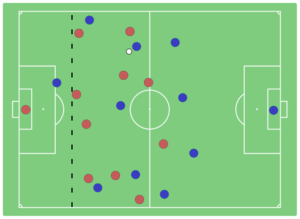Offside (sport) facts for kids
Offside is a rule used in many team sports. It helps control where players can stand on the field or ice. This rule is very common in sports like association football (soccer), rugby union, rugby league, and even 'stick and ball' games like ice hockey and field hockey. It's all about making sure the game is fair and exciting.
Contents
Why Do Sports Have Offside Rules?
Offside rules help make sure players work as a team. They stop players from just waiting near the opponent's goal. This is sometimes called "goalhanging." Without offside, a player could stand by the goal. Then, their teammates could just send a long pass for an easy score.
The offside rule makes the game more challenging. It encourages players to move the ball together. This creates more exciting plays and teamwork. Understanding offside can be tricky at first. But it's a key part of many popular sports.
How the Offside Rule Started
The word "offside" comes from an old military term. It meant someone was "off the strength of his side." This meant they were behind enemy lines. Offside rules began in England in the 1800s. They were used in early forms of football played at schools.
These early rules were often very strict. In some games, a player was offside if they were just standing in front of the ball. This is similar to how the offside rule works in rugby today. Rugby punishes any player who is between the ball and the opponent's goal.
However, some early football games had no offside rule at all. Players called "kick throughs" would stay near the opponent's goal. They were always ready to score.
Offside Rules in Different Sports
The offside rule changes from sport to sport. Here are some sports that use a form of offside:
- American and Canadian football
- Association football (soccer)
- Bandy
- Ice hockey
- Rugby (both union and league)
It's interesting to note that field hockey used to have an offside rule. But it was officially removed in 1998.
Sports Without an Offside Rule
Not all sports have an offside rule. Some football games and 'goal' sports do not use it. This can change how the game is played.
Here are some sports where you won't find an offside rule:
- Australian rules football
- Gaelic football and Hurling
- Smaller versions of association football, like futsal and beach soccer. These games have fewer players.
- Basketball: With only five players, it's harder for one player to stay far ahead. However, some players try "cherry picking." This is when they wait near the opponent's basket for an easy score. Basketball also has a "three seconds rule." This rule stops players from staying too long near the opponent's basket. It acts a bit like a soft offside line.
- Field hockey (since 1998)
- Ringette
- Rinkball
- Net sports like volleyball and tennis. The net acts as a barrier between players.
- Squash and racquetball. Players are often very close. A "let" might be called if a player blocks another.
- Floorball



